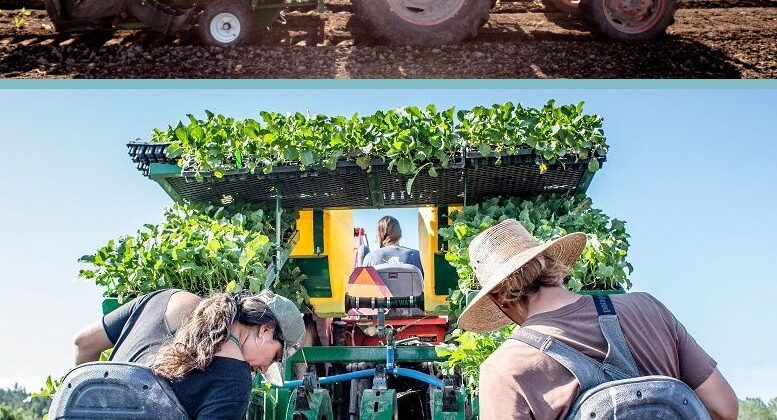The Transplanter
The tractor crawls along, the transplanter rolling behind it – creeping, really, slow and steady. Long, green, metal arms reach out, supporting three seats for three riders. All aboard! We plop down, settling into our positions. The transplanter sways with us, bouncing slightly under our bodies. In front of us are shelves, holding 25 or 30 trays. Each tray made up of 72 or 128 cells, each of these containing a baby plant. We pull trays down from the shelf and into our laps. The tractor hums loudly. The pitch heightens as the tractor accelerates and lulls as the tractor slows.
We move frantically, pulling plants out of the cells with one hand, dropping them to the ground. The other hand is in constant motion, tucking the plant into dibbles and swooshing the soil up over the roots. Dibbles, small holes poked into the ground, are made by the dibbler – three giant wheels at the front of the transplant implement with spikes hooked into the metal. The spikes are removable, allowing you to space holes every 6 or 12 or 18 inches. We follow these dibbles, frantically, dropping and tucking, our bodies bent over to reach the ground, sprawled out across the arm or curled up in the seat of the transplanter.
Transplant feels like a high speed race. Your in constant motion, constantly multitasking. Drop, tuck, swoosh. Drop, tuck, swoosh. All simultaneously. And then the time comes to switch trays. Chaos erupts as we all try to keep filling holes with plants, discard the old tray off to the side, and pull a new tray down and into our laps. Looking down at our hands, the process is rushed. We’re moving as fast as we can, often running just a little behind, missing a hole here and a hole there. You body is pulsing, sort of like the focus and anticipation of playing a game of whack a mole.
For the tractor driver, though, it’s a different pace. The tractor has three speed ranges; snail, turtle, and rabbit (each broken up into low and high gears, with a range of associated speeds). Transplant flows at a snail pace, inching along in the range of 0.1 to 0.26 mph. The experience driving is dramatically different than the experience riding, and when riders take a second to glance up, it’s hilarious to gain perspective. What felt like the fastest you’ve moved all day suddenly shifts to a horizon that is barely moving. You see people moving by foot a little ways down the field, passing you by effortlessly.
But transplanter time runs at a different pace than the workings of the rest of the farm around us. With intense focus, transplanting a few beds at time before loading more trays, the hours pass by quickly. A day can go by in a wink, and looking up there’s a whole field filled new.
~Hannah

